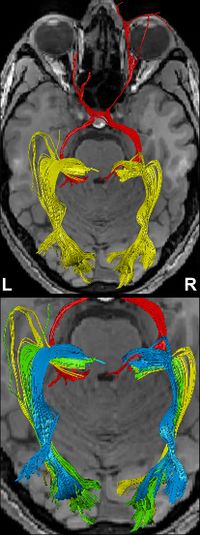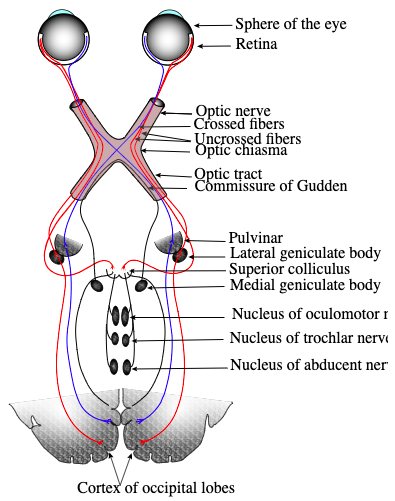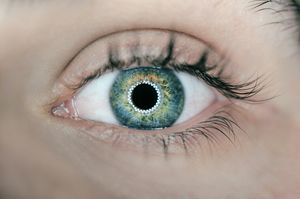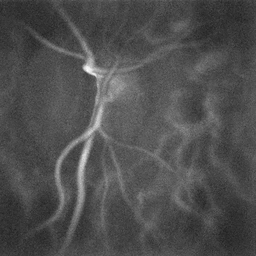The Point Where the Optic Nerve Enters the Retina Is Known as the
Description [edit | edit source]

The optic nerve is a bundle of more than 1 million nerve fibers. Also known as the second cranial nerve or cranial nerve II (CNII), it is the second of several pairs of cranial nerves. It transmits sensory information for vision in the form of electrical impulses from the eye to the brain. Damage to an optic nerve can cause loss of vision. The type of vision loss and its severity depends on where the damage occurs. It may affect one or both eyes[1] [2].
The optic nerve is really an extension of the central nervous system (brain). It is not surrounded by Schwann cells with the first sensory bipolar cell body located peripherally in the retina. Their central processes synapse on ganglion cells (type of neuron located near the inner surface of the retina of the eye) on the vitreous surface of the retina and their central processes pass via the optic disc out of the globe and form the optic nerve proper.
Some features of the optic nerve makes it distinct. In the central nervous system (CNS), the optic nerve is the only cranial nerve to leave the cranial cavity. Also, it is the only cranial nerve that can be visualized clinically. It is has connective tissues and glial septa that subdivide it into fascicles, and it is surrounded by cerebrospinal fluid. [3] [4]
Image 1: Top Bi-hemispheric reconstructions of the optic nerve and tract (red) as well as of the optic radiation (yellow). Bottom Dissection of the optic radiation into Meyer's loop, (yellow), central bundle (green), and dorsal bundle (blue).
Course [edit | edit source]
- The optic nerve begins at the optic disk, a structure that is 1.5 mm (0.06 inch) in diameter and is located at the back of the eye. The optic disk forms from the convergence of ganglion cell output axons as they pass out of the eye.
- The optic disc is the small, circular, optically insensitive region in the retina where fibers of the optic nerve emerge from the eyeball. It has no rods or cones, AKA Blind spot.
-
When the nerve emerges from the back of the eye, it passes through the remainder of the posterior orbit (eye socket) through a structure called the lamina cribrosa that allows the nerve fibers to pass through many holes and into the extraocular (outside of the eyeball) space. As the fibers pass through, they become insulated with glial cells known as oligodendrocytes.
- The nerve then enters the bony optic canal to emerge intracranially on the underside of the front of the brain.
- At this point the optic nerve from each eye comes together and forms an X-shaped structure called the optic chiasm. Here, approximately one-half of the nerve fibres from each eye continue on the same side of the brain, and the remaining nerve fibres cross over at the chiasm to join fibres from the opposite eye on the other side of the brain. This arrangement is essential for producing binocular vision.
- Posterior to the optic chiasm, the nerve fibres travel in optic tracts to various portions of the brain. See image 1.
- Some nerve fibres leave the optic tract without entering the lateral geniculate nuclei and instead enter the brain stem to provide information that ultimately determines pupil size.[5]
Assessment [edit | edit source]
Assessment of the optic nerve is not done in isolation from other cranial nerves that are involved with vision (such CN III, IV, and VI). However, the specific testing of the optic nerve involves visual acuity assessment, color perception, visual fields assessment, and pupillary light reflexes assessment, accommodation assessment and funduscopic examination. [6]
Visual Acuity Test [edit | edit source]
[7]
Color Perception Test [edit | edit source]
[8]
Visual Field Test [edit | edit source]
[9]
Visual Reflexes Test [edit | edit source]
[10]
Fundoscopy Examination [edit | edit source]
[11]
Pathology [edit | edit source]

Pathologies of the optic nerve are categorized into primary and secondary, based on the etiology of the pathology.[12]A traumatic optic neuropathy refers to an injury to the optic nerve after a direct or indirect trauma. Usually, a direct trauma such as a penetrating injury to the optic nerve may result in shearing or hematoma. Indirect injury to the optic nerve results from the transmission of forces to the optic apparatus following a blunt trauma. [13] [14]
Thus, primary pathologies of optic nerve injuries result from concussion, avulsion or tear, contusion, hemorrhage (intraneural/extraneural). Secondary pathologies may arise after edema, ischemia, microvascular thrombosis and infarction of the nerve.[12]
Damage to an optic nerve or damage to its pathways to the brain results in loss of vision. At the optic chiasm, each optic nerve splits, and half of its fibers cross over to the other side. Because of this anatomic arrangement, damage along the optic nerve pathway causes specific patterns of vision loss. By understanding the pattern of vision loss, a doctor can often determine where the problem is in the pathway[15].
There are many different types of optic nerve disorders, including:
- Glaucoma is a group of diseases that are the leading cause of blindness in the United States. Glaucoma usually happens when the fluid pressure inside the eyes slowly rises and damages the optic nerve.
- Optic neuritis is an inflammation of the optic nerve. Causes include infections and immune-related illnesses such as multiple sclerosis. Sometimes the cause is unknown.
- Optic nerve atrophy is damage to the optic nerve. Causes include poor blood flow to the eye, disease, trauma, or exposure to toxic substances.
- Optic nerve head drusen are pockets of protein and calcium salts that build up in the optic nerve over time[2] [5].

The anatomy of the optic nerve makes it a sensitive marker for problems inside the brain. This nerve connects the back of each eyeball and its retina to the brain. In its short span between the brain and the eye, the optic nerve's whole surface is bathed in cerebral spinal fluid.
- However, even slight increases in the pressure of this fluid, from swelling of the brain, can compress the optic nerve around its whole circumference in a "choking" manner. Some important causes of increased pressure from cerebral spinal fluid and papilledema are brain tumors and brain infections, such as a brain abscess, meningitis or encephalitis. A significant proportion of people who are diagnosed with brain tumors have some evidence of papilledema. A pressure increase resulting from bleeding or from very high blood pressure also can cause papilledema.[16].
- Image 3. Laser Doppler holography of blood flow in the optic nerve head region of the human retina.
References [edit | edit source]
- ↑ Very well health Optic Nerve Available from: https://www.verywellhealth.com/optic-nerve-anatomy-4686150(accessed 4.2.2021)
- ↑ 2.0 2.1 Medline plus Optic Nerve Available from:https://medlineplus.gov/opticnervedisorders.html (accessed 4.2.2021)
- ↑ Mcmenamin P, Forrester JV, Dick AD, Lee WR. The Eye-Basic Sciences in Practice.
- ↑ Salazar JJ, Ramírez AI, De Hoz R, Salobrar-Garcia E, Rojas P, Fernández-Albarral JA, López-Cuenca I, Rojas B, Triviño A, Ramírez JM. Anatomy of the human optic nerve: Structure and function. Optic Nerve. 2018 Nov 5.
- ↑ 5.0 5.1 Britannica Optic Nerve Available from:https://www.britannica.com/science/optic-nerve (accessed 4.2.2021)
- ↑ Lorenzo Crumbie. Cranial neves examination: Optic nerve. Kenhub, 2021. Available at: https://www.kenhub.com/en/library/anatomy/clinical-examination-of-the-optic-nerve Accessed on October, 4, 2021
- ↑ UBC Medicine | Visual Acuity -Ophthalmology -Ep 4. Available from: https://www.youtube.com/watch?v=0uDciOi6uYE [Last accessed 10/4/2021]
- ↑ Doctor Eye Health | The Ishihara Color Blind Test (Are You Colorblind?) Available at: https://www.youtube.com/watch?v=VUq_Y3sUYO4 [Last accessed: 10/4/2021]
- ↑ UBC Medicine | Confrontational Visual Fields - Ophthalmology -Ep 8. Available at: https://www.youtube.com/watch?v=Vp7LBSe7DcI [Last accessed: 10/4/2021]
- ↑ RegisteredNurseRN | How to Check Pupil Relexes Response | Consensual and Direct Reaction | Nursing Clinical Skills. Available at: https://www.youtube.com/watch?v=aM0ipmW3ikc [Last accessed 10/04/2021]
- ↑ Geeky Medics | Fundoscopy (Ophthalmoscopy) -OSCE Guide. Available at: https://www.youtube.com/watch?v=SVuP5Td23AQ [Last accessed: 10/04/2021]
- ↑ 12.0 12.1 Tandon V, Mahapatra AK. Current Management of Optic Nerve Injury. Indian Journal of Neurosurgery. 2017 Aug;6(02):083-5.
- ↑ Steinsapir KD, Goldberg RA. Traumatic optic neuropathy: an evolving understanding. American journal of ophthalmology. 2011 Jun 1;151(6):928-33.
- ↑ Thaker A, Tandon DA, Mahapatra AK. Surgery for optic nerve injury: should nerve sheath incision supplement osseous decompression?. Skull Base. 2009 Jul;19(04):263-71.
- ↑ MSD manauls eye Disorders Available from: https://www.msdmanuals.com/en-au/home/eye-disorders/optic-nerve-disorders/overview-of-optic-nerve-disorders (accessed 4.2.2021)
- ↑ Drugs.com Optic nerve Available from: https://www.drugs.com/health-guide/optic-nerve-swelling-papilledema.html (accessed 4.2.2021)
The Point Where the Optic Nerve Enters the Retina Is Known as the
Source: https://www.physio-pedia.com/Optic_Nerve
0 Response to "The Point Where the Optic Nerve Enters the Retina Is Known as the"
Post a Comment